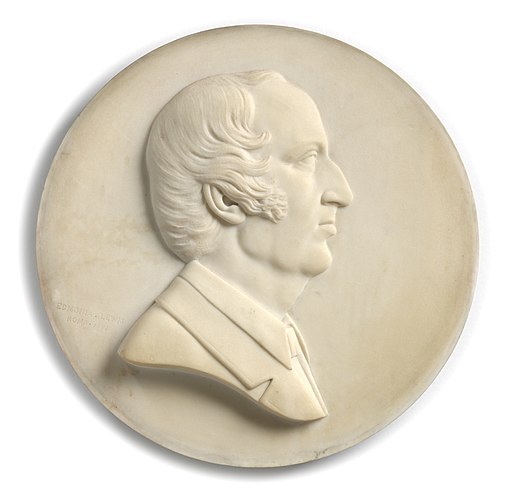Today we continue our celebration of Women's History Month by learning about the first person of color who became famous as a sculptor. Besides being a famous artist, she also had a very interesting life story and background. Throughout her life she dealt with racism and sexism. She was orphaned at a young age. She was biracial--Black and Native American. Her name is Edmonia Lewis or Mary Edmonia Lewis or Wildfire.
 |
| Edmonia Lewis circa 1870 Source: Bluesy Daye, Public domain, via Wikimedia Commons |
Mary Edmonia Lewis was born on or about July 4, 1844, in Greenbush, New York to Samuel and Hannah S. Lewis. Samuel was a Haiti-American and Hannah was Chippewa. She was orphaned at an early age (around three or four). She was brought up by some of Hannah's sisters. Her Native name is Wildfire. Her older brother supported her education at Oberlin College. It was one of the first colleges to admit Black and females. Unfortunately, she did not graduate. In 1862, she was falsely accused of poisoning two of her white classmates. She was captured and beaten by a white mob. Then in 1863, she was accused of stealing brushes, paints, and a picture frame. The charges were quickly dropped but Oberlin would not permit her to finish her final term. She met Frederick Douglass at Oberlin and he suggested she go East. She escaped to Boston, Massachusetts after her name was cleared. In Boston she apprenticed under sculptor Edward A. Brackett, for a short time. She also met Lydia Maria Child. Lydia was a feminist and found of the New England abolitionist movement. She quickly recognized Edmonia's talent. Edmonia sculpted portraits of William Lloyd Garrison, Charles Sumner, and Wendell Phillips.
 |
| Marble Relief of Wendell Phillips by Edmonia Lewis, 1871 Source: Edmonia Lewis, CC0, via Wikimedia Commons |
In 1864 Edmonia created a bust of Colonel Robert Gould Shaw. Lydia had encouraged her not to create it without meeting him, but Edmonia created it from photos. She also created a statuette of Sargeant William H. Carney from the 54th Massachusetts Regiment. The sale of her portrait busts of Colonel Robert Gould Shaw and John Brown funded her first trip to Europe. She sold 100 copies of the Colonel Shaw bust and some photos of it. She had the blessing of the Shaw family to sell them. In December of 1864, Anna Q. Waterston wrote a poem about Edmonia and the Colonel Shaw bust. In January 1865, Lydia Child publicized the bust in The National Anti-Slavery Standard and The Liberator. In August Edmonia set sail for Europe.
 |
| Anna Quincy Waterston by Edmonia Lewis Source: ©David Finn Archive, Department of Image Collections, National Gallery of Art Library, Washington, DC, CC BY-SA 4.0, via Wikimedia Commons |
Eventually she settled in Rome, Italy. She learned Italian and rented a studio near the Piazza Barberini. She became acquainted with Harriet Hosmer and other American female sculptors. They had been drawn to Rome because of the white marble and the stone cutters. Edmonia was unique from the other sculptors in the way she did not hire the Italian stone cutters. Some say it was due to financial issues and others say she did not want there to be any way people could say it was not her work due to her race and gender. In Rome her work often went between African American themes and her Catholic religion.
 |
| Old Arrow Maker Source: Edmonia Lewis (July 1845 - 17 September 1907), Public domain, via Wikimedia Commons |
In February 1866, Edmonia created Freedwoman and Her Child, which was the first feminist Emancipation statue created by an African American. In 1866 she also sculpted the Old Arrow Maker and His Daughter, The Marriage of Hiawatha (pictured in the title picture above) and Forever Free, her second Emancipation sculptor. As you can see her own heritage played a role in her creations.
 |
| Forever Free by Edmonia Lewis Source: Edmonia Lewis, Public domain, via Wikimedia Commons |
In 1870s Edmonia returned to America several times to exhibit several of her sculptures. Her sculpture The Death of Cleopatra never returned to Italy. Edmonia could not afford to ship it back. It weighs two tons. It was put in storage and rediscovered several decades after her death. There are many stories of it appearing in different locations including a Chicago saloon, a grave marker for a racehorse, and a Chicago scrap yard. In 1995 it was acquired and restored by the Smithsonian American Art Museum.
 |
| The Death of Cleopatra Source: Edmonia Lewis (July 1845 - 17 September 1907), Public domain, via Wikimedia Commons |
In 1887, Frederick Douglass and his wife met with Edmonia in Rome. She traveled with them to Naples. In 1893 she was living in Paris, France. In 1901, she lived in London, England. She died on September 17, 1907, in London. Her death however went unnoticed and in fact in 1909 a false claim of her being alive was in the news. On October 7, 2017, her grave in England finally got a proper headstone marking her final resting place.
Besides looking at the photographs you can find of her artwork with kids, there are some books that feature her and several of them are children's books though many are for the older children. Here are the books I found for you.
Other Sources:
Biography.com Editors. Biography.com. "Edmonia Lewis Biography." (2 Apr 2014) https://www.biography.com/artist/edmonia-lewis
EdmoniaLewis.com. "Biography-Chronology." Chronology (edmonialewis.com)
EdmoniaLewis.com. "How Edmonia Lewis Became an Artist." 1870 HOW EDMONIA LEWIS BECAME AN ARTIST
Smithsonian American Art Museum. "Edmonia Lewis." Edmonia Lewis | Smithsonian American Art Museum (si.edu)
Smithsonian Arts Museum. Google Arts & Culture. "Edmonia Lewis." Edmonia Lewis — Google Arts & Culture



No comments:
Post a Comment
I love to hear your comments and ideas. Thank you for reading and contributing!